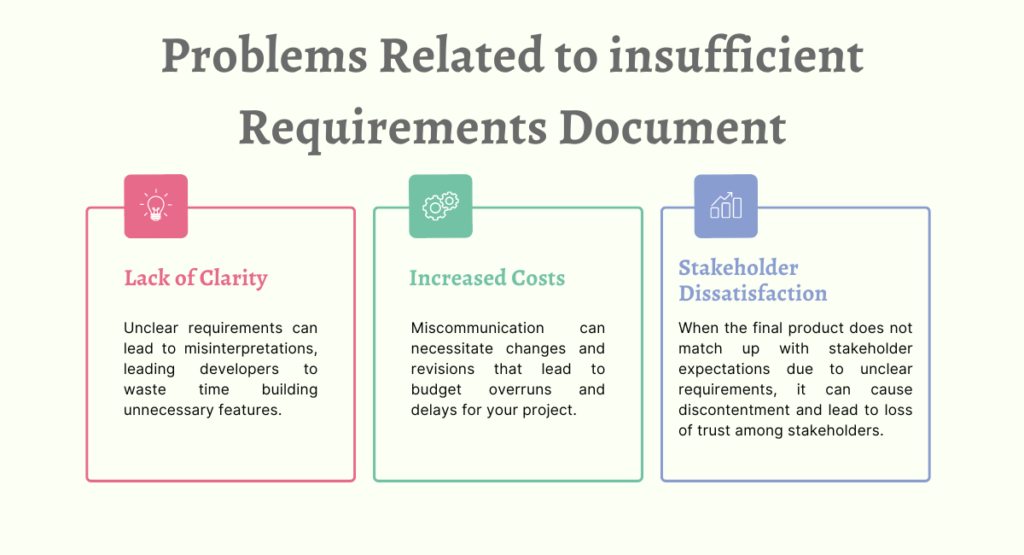Traditional software development models rely on comprehensive requirements documents as the cornerstone of project success, yet in today's rapidly-evolving technological environment they may actually hinder rather than help.
Enter Agile development--an approach which emphasizes flexibility and ongoing iteration over strict adherence to initially specified requirements.
Agile has revolutionized how teams manage project uncertainties; making its absence less of an impediment but more of an opportunity for innovation and responsive development.
Requirements Document in Software Development
Requirements documents play a pivotal role in software development, acting as the blueprint of what should be built. They typically detail functionality, interface, behavior and integration of the software with other systems - providing developers, project managers and stakeholders a dependable reference point against which their goals and deliverables can be measured against.
Traditional Perspectives on Requirements Document
Traditionally, requirements documents have always been seen as the cornerstone of software projects. The general belief is that an in-depth and thoroughly prepared requirements document can significantly decrease risks associated with development by eliminating miscommunication, scope creep and missed objectives.
In tandem with this extensive documentation process are often comprehensive planning stages designed to bring clarity and direction throughout the lifecycle process of software production.
Problems Related to insufficient Requirements Document

An incomplete requirements document can pose major obstacles:
- Lack of Clarity: Unclear requirements can lead to misinterpretations, leading developers to waste time building unnecessary features.
- Increased Costs: Miscommunication can necessitate changes and revisions that lead to budget overruns and delays for your project.
- Stakeholder Dissatisfaction: When the final product does not match up with stakeholder expectations due to unclear requirements, it can cause discontentment and lead to loss of trust among stakeholders.
These obstacles demonstrate the significance of properly written requirements documents in traditional software development methods.
Understanding Agile Development concepts.
Agile development methodologies offer a refreshing alternative to more traditional software project management approaches like waterfall. Agile stresses flexibility, continuous improvement and providing value quickly to customers.
Definition of Agile Methodologies (AM).
Agile methodologies encompass a group of software development practices characterized by iterative and incremental progress, where solutions emerge through collaboration among self-organizing cross-functional teams.
Their goal is to quickly adapt to change while consistently delivering functional pieces of the product on schedule.
Principles of Agile Software Development
The Agile Manifesto details the core principles of agile programming as outlined by its creators:
Customer Satisfaction through Early and Ongoing Software Delivery: Customers become more involved and can see tangible results at every step.
- Accept Change: Agile teams must welcome changing requirements even during late stages of development.
- Frequent Delivery: Companies typically release products in waves over time ranging from weeks to months, with an emphasis on shorter delivery schedules.
- Collaborative Work Environment: Developers, business people and other project stakeholders collaborate regularly throughout their projects.
- Sustainable development: All stakeholders involved, such as developers, sponsors and users should be able to maintain an uninterrupted pace for indefinite development.
These principles encourage a flexible environment where change is seen as an opportunity for adding value to the end product, mitigating any adverse impact from an inadequate initial requirements document through continuous input and feedback loops that form part of the process.
How Agile Development Overcomes Insufficient Requirements Document
Flexibility in Agile Processes
Agile methodologies' flexibility makes them ideal for projects with incomplete or ever-evolving requirements documents, making agile development especially appropriate in cases with incomplete requirements documents or evolving ones.
While traditional models rely heavily on fixed requirements documents for guidance during development processes, agile development embraces changes even after progress has already started.
It does so through regular review cycles known as sprints that enable teams to adjust course based on feedback or new insights gathered during sprints - this ensures product constantly moves towards user requirements even if these weren't fully defined at project start.
Agile development emphasizes collaboration as a central project component, setting it apart from more traditional development methodologies which tend to dictate requirements from above with little ongoing discussion or dialogue between parties involved.
Agile teams typically include members from various disciplines working closely together with stakeholders and clients to refine the product continuously - this ensures any lack of details in requirements documents is quickly identified and addressed as soon as they arise.
Regular meetings such as daily stand-ups and sprint reviews foster an environment of transparency and collective accountability which helps fill any gaps that exist between documentation and production.
Utilizing an iterative approach in Agile projects.
Agile methodologies employ an iterative approach that makes inadequate initial documentation less of a hurdle. By breaking their project down into manageable units (sprints), agile teams can focus on producing small incremental releases.
At each release milestone, teams reassess project priorities and requirements, making adjustments based on real world testing/feedback - this allows agile teams to easily accommodate changes while also producing products tailored more closely towards meeting user needs as they become better understood over time.
Successful Project Management with Agile Practices
Real-Life Examples of Agile Success Stories
Numerous companies, from startups to global enterprises, have experienced notable improvements in project outcomes through agile practices.
One such example is Spotify which widely embraces agile principles within its engineering culture; emphasizing team autonomy and iterative product development processes which has enabled it to remain innovative.
IBM and Microsoft also adopted agile frameworks as ways to accelerate product development cycles while increasing client satisfaction, showing its effectiveness across different industries and project scales.
Comparative Study on Agile vs Traditional Project Management Strategies
| Aspect | Agile | Traditional (Waterfall) |
|---|---|---|
| Approach | Iterative, incremental | Sequential, linear |
| Flexibility | Embraces change | Less adaptable to change |
| Requirements | Evolving, can be adjusted | Defined upfront, less flexible |
| Planning | Adaptive, frequent iterations | Detailed upfront, less iteration |
| Communication | Collaborative, frequent | Formalized, less frequent |
| Customer Involvement | High, continuous engagement | Limited, typically at the beginning |
| Risk Management | Continuous throughout | Addressed mainly at the start |
| Delivery | Incremental, frequent releases | Single release at the end |
| Progress Tracking | Regular checkpoints, transparency | Milestone-based, less transparent |
| Team Structure | Cross-functional, self-organizing | Hierarchical, specialized roles |
| Documentation | Light, emphasis on working code | Comprehensive, detailed documents |
| Feedback | Regular, immediate | Limited, typically at milestones |
| Response to Change | Welcomed, integrated | Can be challenging, requires formal process |
Agile project management offers distinct advantages when dealing with projects with shifting requirements. Traditional project management methodologies like Waterfall depend heavily on creating an unchanging requirements document; any deviation can cause costly delays and prolong decision-making processes.
Conversely, agile's flexible and iterative nature enables continual requirement refinements without derailing project timeline. This flexibility not only decreases project failure risks but also allows teams to meet actual user demands effectively.
Book a Demo and experience ContextQA testing tool in action with a complimentary, no-obligation session tailored to your business needs.
Conclusion
Traditional models of software development rely heavily on comprehensive requirements documents; the agile approach proves this is no longer essential to project success.
Agile methodologies emphasize flexibility, continuous feedback, and adaptability; this allows development teams to thrive even when requirements are vague or incomplete.
Agile projects benefit from accepting change and prioritizing incremental improvements by welcoming it, in order to produce functional software which meets clients' ever-evolving requirements.
Under conditions of rapid technology evolution and market instability, being agile is more valuable than having extensive requirements documents.
Therefore, insufficient requirements documentation shouldn't be seen as a burden; rather it should be seen as an opportunity to break out from conventional project management and software development practices.
Also Read - Do we need a test review similar to code review?
